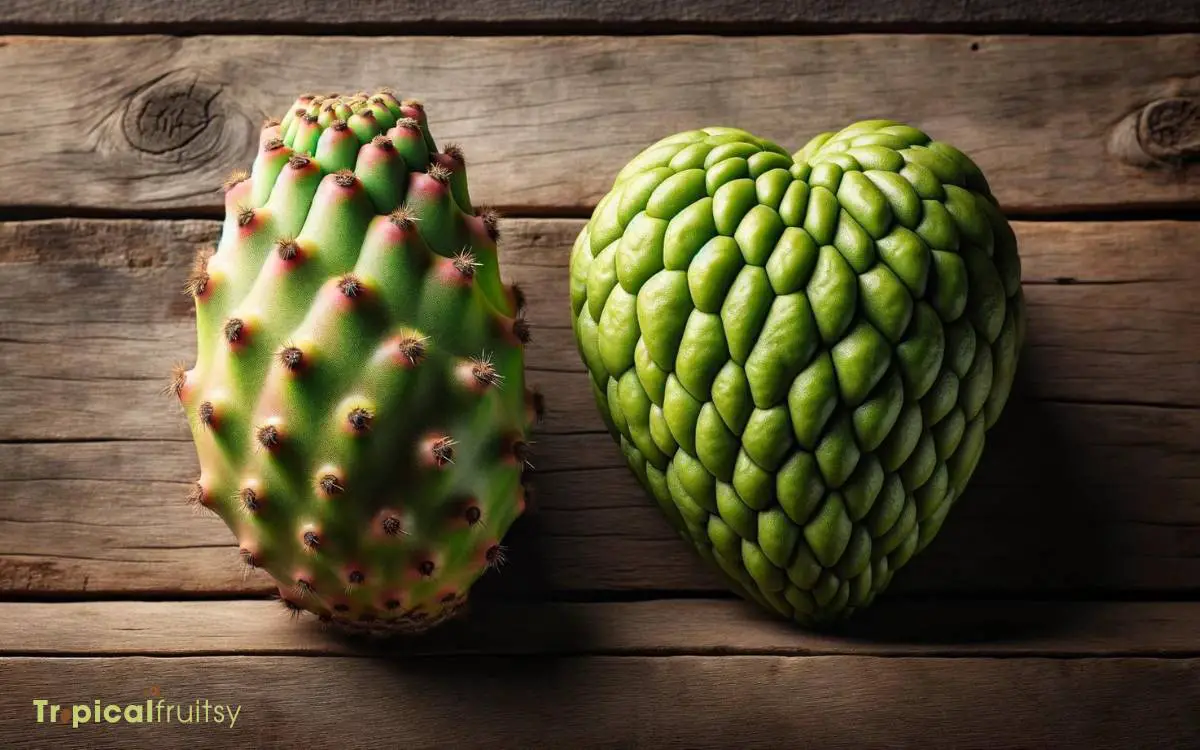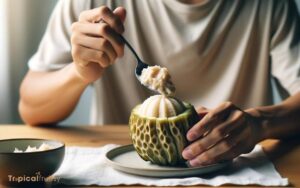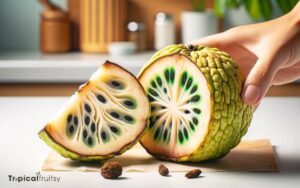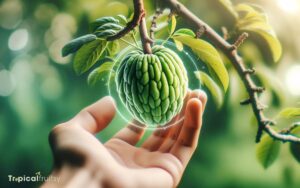Compare a Prickly Pear with a Cherimoya: Exotic Showdown!
Prickly pears and cherimoyas are two distinct fruits cultivated in California, each with unique characteristics and benefits.
The prickly pear is known for its spiny exterior and sweet, melon-like flavor, while the cherimoya boasts a soft, green skin with a custard-like texture and a flavor reminiscent of a mix of banana, pineapple, and strawberry.
Both fruits are rich in nutrients and offer a range of culinary uses.
Prickly pears, originating from arid desert environments, have adapted a tough skin to protect their moisture-rich flesh. In contrast, cherimoyas, from tropical regions, have a more delicate skin and a creamy texture.
Nutrition-wise, prickly pears are high in fiber, vitamins C and K, calcium, and magnesium. Cherimoyas are rich in vitamin C, B vitamins, potassium, and dietary fiber.
To enjoy these fruits:
Explore the exotic flavors of prickly pears and cherimoyas to add a nutritious twist to your diet.

Key Takeaway
Both fruits provide essential nutrients and antioxidants for overall health.
Prickly Pear vs. Cherimoya: A Comparative Guide
| Feature | Prickly Pear | Cherimoya |
|---|---|---|
| Origin | Arid deserts | Tropical regions |
| Exterior | Tough and spiny | Soft and green |
| Texture | Juicy | Custard-like |
| Flavor | Sweet, melon-like | Banana, pineapple, strawberry |
| Nutritional Content | Vitamins C and K, calcium | Vitamins C, B, potassium |
| Culinary Uses | Jams, juices, salads | Desserts, smoothies, eaten raw |
| Storage | Room temp. or refrigerated | Room temp. until ripe, then refrigerated |
Origin and Habitat
The prickly pear, native to the Americas, thrives in arid and semiarid regions, while the cherimoya originates from the Andes and prefers subtropical climates.
The prickly pear’s adaptability to water-scarce environments is facilitated by its crassulacean acid metabolism (CAM), which allows for nocturnal stomatal opening, minimizing water loss.
Conversely, the cherimoya requires a more hydrated ecosystem, as its physiology lacks such drought-resistant adaptations. Its cultivation is consequently localized to areas with ample moisture and protection from extreme temperatures.
The prickly pear’s distribution extends from the southern United States to Argentina, reflecting its robust nature. The cherimoya, however, demonstrates a narrower habitat range, predominantly in South America.
Physical Characteristics
Both prickly pears and cherimoyas exhibit markedly different physical attributes that reflect their respective habitats.
Prickly pears, members of the Opuntia genus, possess a unique morphology with flat, rounded cladodes known as pads, which are adapted for arid conditions.
These pads are covered with spines and barbed bristles, deterring predators and minimizing water loss.
In contrast, the cherimoya (Annona cherimola) has a distinctly tropical fruit appearance, with heart-shaped, green-skinned fruits that have a leathery texture and a surface pattern resembling overlapping scales.
The inner flesh of the cherimoya is creamy and custard-like, containing numerous large, black seeds.
Analyzing these characteristics reveals evolutionary adaptations: the robust, water-conserving form of the prickly pear and the nutrient-rich, seed-bearing structure of the cherimoya.
Nutritional Value
Transitioning from their distinct physical traits, prickly pears and cherimoyas also differ significantly in their nutritional profiles.
Prickly pears contain dietary fiber, vitamin C, calcium, and antioxidants, particularly betalains which confer anti-inflammatory properties. They’re relatively low in calories, making them a suitable addition to weight management diets.
Cherimoyas, on the other hand, are rich in vitamin C, offering a higher percentage per serving compared to prickly pears.
They also boast a considerable amount of dietary fiber, vitamin B6, and riboflavin, essential for energy metabolism.
Notably, cherimoyas provide a unique assortment of nutrients, including potassium and magnesium, which are crucial for cardiovascular health.
The nutritional distinctions set the stage for an exploration of their flavor profiles, where sensory experiences further distinguish these exotic fruits.
Flavor Profiles
Delving into their flavor profiles, each fruit offers a distinct palate experience. Prickly pears provide a subtly sweet taste with a hint of watermelon.
The prickly pear’s flavor is mildly reminiscent of natural sugars with an underlying note of melon, specifically watermelon, and a slight tanginess that can vary depending on ripeness.
In contrast, cherimoyas are often described as a blend of banana, pineapple, and strawberry.
The cherimoya’s complex flavor profile exhibits a symphony of tropical and subtropical fruit nuances. It boasts a rich, creamy texture that carries the sweetness of banana, the tartness of strawberry, and the tropical zing of pineapple.
These sensory attributes make cherimoyas particularly appealing for culinary applications that require a nuanced fruit component.
Culinary Uses
Prickly pears are often used to add a subtle sweetness to cocktails and desserts, whereas cherimoyas are regularly incorporated into smoothies and custards for their rich, tropical flavor.
In culinary applications, chefs value prickly pears for their versatility. The fruit’s juice serves as a natural sweetener and its vibrant hue enhances the visual appeal of dishes.
Meanwhile, cherimoyas provide a creamy texture that complements dairy-based recipes. The fruit’s flesh, when pureed, imparts a custard-like consistency desirable in pastry creams and mousses.
Both fruits can be challenging to prepare due to their seeds, but the effort yields a distinctive flavor profile that’s sought after in gourmet cooking.
Health Benefits
Both fruits offer essential nutrients that can bolster overall health and support various bodily functions.
Prickly pear, for instance, contains high levels of fiber, which aids in digestion and helps regulate blood sugar levels. It’s also rich in antioxidants, particularly betalains, which combat oxidative stress and may reduce the risk of chronic diseases.
Cherimoya, on the other hand, is a significant source of vitamin C, essential for immune system function, and vitamin B6, which is vital for brain health.
Additionally, this fruit is abundant in potassium, aiding in cardiovascular health by maintaining proper blood pressure and electrolyte balance.
Together, prickly pear and cherimoya provide a diverse range of bioactive compounds that contribute to a well-rounded diet and promote physiological resilience.
Purchasing and Storage
When buying cherimoya or prickly pear, it’s important to choose ripe fruits and store them correctly to maintain freshness and flavor.
Customers should examine cherimoyas for a slight give under gentle pressure, indicative of ripeness, while prickly pears should have deep, uniform coloration.
To ensure optimal preservation:
- Keep cherimoyas at room temperature until fully ripe, then refrigerate to slow further ripening.
- Store prickly pears in a cool, dry place and avoid stacking, which may lead to bruising.
- Consume both fruits within a few days of ripening for best taste and nutritional value.
Proper storage methods extend the life of the fruit, retaining essential nutrients.
Preparing and Serving Tips
The preparation of prickly pears necessitates careful peeling to remove the skin and spines. Cherimoyas, on the other hand, require a simpler slicing method.
Efficient seed removal techniques are crucial for both fruits. This ensures that the fruit’s edible portions are enjoyed without the risk of ingesting hard seeds.
When it comes to serving, both fruits offer diverse options. They can be consumed raw or incorporated into sophisticated culinary dishes.
Peel or Slice
Prickly pears require careful peeling to remove their spiny outer skin, while cherimoyas are often sliced open to access their creamy interior.
The preparation of these fruits necessitates distinct approaches:
- For prickly pears, specialized tools such as tongs and gloves are recommended to handle and remove the hazardous glochids.
- Cherimoyas, in contrast, should be sliced along the equator and the flesh scooped out with a spoon, similar to an avocado.
- Both fruits can be chilled prior to serving, which enhances their flavor and makes handling easier.
This meticulous preparation serves not only to present the fruits at their best but also to facilitate the next step: the removal of seeds.
Seed Removal Techniques
Cherimoya’s seeds are easily removed once the fruit is halved. To prepare cherimoya for consumption, one should slice the fruit into two symmetrical halves.
Then, employing a spoon, they can gently scoop out the large, black seeds from the cream-colored pulp. This method ensures the flesh remains intact for serving.
Conversely, prickly pear seeds present a challenge due to their integration within the fruit’s edible portion. The recommended approach involves consuming the flesh and seeds together, then discretely spitting out the seeds.
Alternatively, one can process the prickly pear in a blender and strain the mixture to separate the seeds from the juice. This technique yields a seedless product suitable for various culinary applications.
Serving Suggestions
Fruit enthusiasts can enjoy prickly pears and cherimoyas in a variety of dishes, from refreshing salads to decadent desserts.
When preparing these fruits, the culinary approach must consider the textural elements and flavor profiles specific to each.
- Prickly pears: Their vibrant, mildly sweet flesh complements citrus-based dressings in salads and serves as a visually appealing garnish.
- Cherimoyas: The creamy texture is ideal for pureeing into mousse or custard, offering a rich, tropical essence to these confections.
- Combined use: In a fruit salad, they provide contrasting textures; the prickly pear adds a refreshing bite, while the cherimoya contributes a lush, smooth component.
These serving suggestions are predicated on the proper handling of the fruits, ensuring that the inherent qualities are neither diminished nor compromised.
Conclusion
While both the prickly pear and cherimoya hail from distinct habitats and boast unique physical traits, they contribute valuable nutrients to a balanced diet.
Their flavor profiles and culinary applications differ, with the prickly pear offering a subtler taste compared to cherimoya’s rich creaminess.
Optimizing their health benefits involves proper storage and preparation. For instance, a chef might highlight the cherimoya’s tropical notes in a dessert, underscoring its versatility beyond its spiky exterior.






